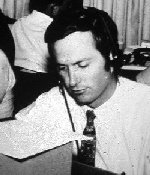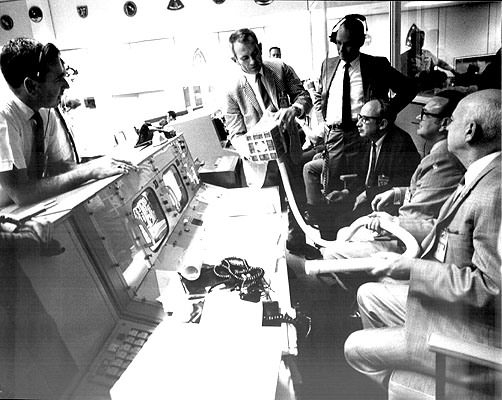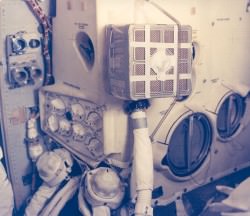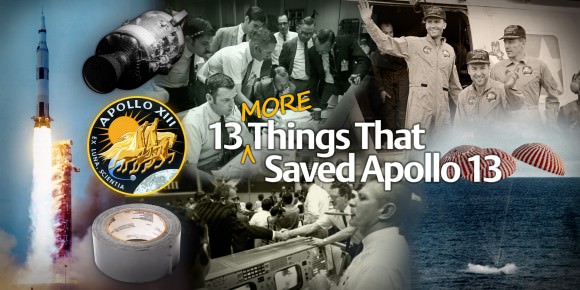The Apollo 13 accident crippled the spacecraft, taking out the two main oxygen tanks in the Service Module. While the lack of oxygen caused a lack of power from the fuel cells in the Command Module, having enough oxygen to breathe in the lander rescue craft really wasn’t an issue for the crew. But having too much carbon dioxide (CO2) quickly did become a problem.
The Lunar Module, which was being used as a lifeboat for the crew, had lithium hydroxide canisters to remove the CO2 for two men for two days, but on board were three men trying to survive in the LM lifeboat for four days. After a day and a half in the LM, CO2 levels began to threaten the astronauts’ lives, ringing alarms. The CO2 came from the astronauts’ own exhalations.

NASA engineer Jerry Woodfill helped design and monitor the Apollo caution and warning systems. One of the systems which the lander’s warning system monitored was environmental control.
Like carbon monoxide, carbon dioxide can be a ‘silent killer’ – it can’t be detected by the human senses, and it can overcome a person quickly. Early on in their work in assessing the warning system for the environmental control system, Woodfill and his co-workers realized the importance of a CO2 sensor.
“The presence of that potentially lethal gas can only be detected by one thing – an instrumentation transducer,” Woodfill told Universe Today. “I had an unsettling thought, ‘If it doesn’t work, no one would be aware that the crew is suffocating on their own breath.’”
The sensor’s job was simply to convert the content of carbon dioxide into an electrical voltage, a signal transmitted to all, both the ground controllers, and the cabin gauge.

“My system had two categories of alarms, one, a yellow light for caution when the astronaut could invoke a backup plan to avoid a catastrophic event, and the other, an amber warning indication of imminent life-threatening failure,” Woodfill explained. “Because onboard CO2 content rises slowly, the alarm system simply served to advise and caution the crew to change filters. We’d set the threshold or “trip-level” of the alarm system electronics to do so.”
And soon after the explosion of Apollo 13’s oxygen tank, the assessment of life-support systems determined the system for removing carbon dioxide (CO2) in the lunar module was not doing so. Systems in both the Command and Lunar Modules used canisters filled with lithium hydroxide to absorb CO2. Unfortunately the plentiful canisters in the crippled Command Module could not be used in the LM, which had been designed for two men for two days, but on board were three men trying to survive in the LM lifeboat for four days: the CM had square canisters while the LM had round ones.

As was detailed so well by Jim Lovell in his book “Lost Moon,” and subsequently portrayed in detail in the movie “Apollo 13,” a group of engineers led by Ed Smylie, who developed and tested life support systems for NASA, constructed a duct-taped-jury-rigged CO2 filter, using only what was aboard the spacecraft to convert the plentiful square filters to work in the round LM system. (You can read the details of the system and its development in our previous “13 Things” series.)
Needless to say, the story had a happy ending. The Apollo 13 accident review board reported that Mission Control gave the crew further instructions for attaching additional cartridges when needed, and the carbon dioxide partial pressure remained below 2mm Hg for the remainder of the Earth-return trip.
But the story of Jerry Woodfill and the CO2 sensor can also serve as an inspiration to anyone who feels disappointed in their career, especially in STEM (science, technology, engineering and math) fields, feeling that perhaps what you are doing doesn’t really matter.
“I think almost everyone who came to NASA wanted to be an astronaut or a flight director, and I always felt my career was diminished by the fact that I wasn’t a flight controller or astronaut or even a guidance and navigation engineer,” Woodfill said. “I was what was called an instrumentation engineer. Others had said this is the kind of job that was superfluous.”
Woodfill worked on the spacecraft metal panels which housed the switches and gauges. “Likely, a mechanical engineer might not find such a job exciting,” he said, “and to think, I had once studied field theory, quantum electronics and other heady disciplines as a Rice electrical engineering candidate.”

Later, to add to the discouragement was a conversation with another engineer. “His comment was, ‘No one wants to be an instrumentation engineer,” Woodfill recalled, “thinking it is a dead-end assignment, best avoided if one wants to be promoted. It seemed that instrumentation was looked upon as a sort of ‘menial servant’ whose lowly job was servicing end users such as radar, communications, electrical power even guidance computers. In fact, the users could just as readily incorporate instrumentation in their devices. Then, there would be no need for an autonomous group of instrumentation guys.”
But after some changes in management and workforce, Woodfill became the lead Command Module Caution and Warning Project Engineer, as well as the Lunar Lander Caution and Warning lead – a job he thought no one else really wanted.
But he took on the job with gusto.
“I visited with a dozen or more managers of items which the warning system monitored for failure,” Woodfill said. He convened a NASA-Grumman team to consider how best to warn of CO2 and other threats. “We needed to determine at what threshold level should the warning system ring an alarm. All the components must work, starting with the CO2 sensor. The signal must pass from there through the transmitting electronics, wiring, ultimately reaching my warning system “brain” known as the Caution and Warning Electronics Assembly (CWEA).”
And so, just hours after the explosion on Apollo 13, the Mission Engineering Manager summoned Woodfill to his office.
“He wanted to discuss my warning system ringing carbon dioxide alarms,” Woodfill said. “I explained the story, placing before him the calibration curves of the CO2 Partial Pressure Transducer, showing him what this instrumentation device is telling us about the threat to the crew.”
Now, what Woodfill had once had deemed trivial was altogether essential for saving the lives of an Apollo 13 astronaut crew. Yes, instrumentation was just as important as any advanced system aboard the command ship or the lunar lander.
“And, I thought, without it, likely, no one would have known the crew was in grave danger,” said Woodfill, “let alone how to save them. Instrumentation engineering wasn’t a bad career choice after all!”

And it was one of the additional things that saved Apollo 13.

Additional articles in this series:
Part 1: The Failed Oxygen Quantity Sensor
Part 2: Simultaneous Presence of Kranz and Lunney at the Onset of the Rescue
Part 3: Detuning the Saturn V’s 3rd Stage Radio
Part 4: Early Entry into the Lander
Part 5: The CO2 Partial Pressure Sensor
Part 6: The Mysterious Longer-Than-Expected Communications Blackout
Part 7: Isolating the Surge Tank
Part 8: The Indestructible S-Band/Hi-Gain Antenna
Part 10: ‘MacGyvering’ with Everyday Items
Part 11: The Caution and Warning System
Part 12: The Trench Band of Brothers
Find all the original “13 Things That Saved Apollo 13″ (published in 2010) at this link.

